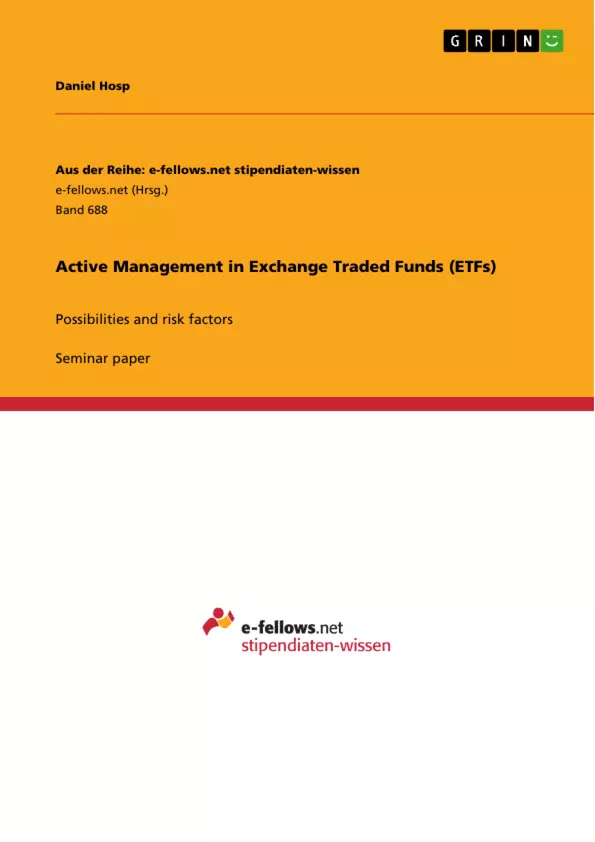It seems to be common that financial products are developed further and further, making them more and more complex. This process sometimes continues until nobody is any more able to exactly assess the contained risks. Such a trend can currently be observed in the Exchange Traded Funds business where especially active managed ETFs increasingly become unpredictable. This is most harmful for non-professionals and privates who clearly do not fully understand those products and their ramifications.
Based on the few material that is currently available in this field “Active Management in ETFs - Possibilities and risk factors” provides new insights about the risks of active management in ETFs. It is most important to early highlight and understand upcoming risks before it is already too late, as it has been the case several times before for other highly innovative and strongly growing financial products.
Constructing on the first paper about ETFs from Baumgartner and Hosp (2013), which gave a broad overview about the basics of ETFs and their risks, this paper focuses on the possibilities of active asset management in ETFs and their risks. A huge innovation process currently occurs in the ETF business and broad up actively managed ETFs and managed ETF portfolios. These type of funds very quickly obtained popularity and thus it is one of the latest topics.
The paper is structured as follows: After the introduction an overview about the development of active management in ETFs is given. Ongoing section 3 describes active ETFs and compares them with mutual funds in mainly three aspects: costs, transparency and liquidity. Section 4 continues with managed ETF portfolios followed by a short outlook on the development of the active ETF business in section 5 and a conclusion in section 6.
Inhaltsverzeichnis (Table of Contents)
- Introduction
- Development of the active ETF business
- Active ETFs - A comparison with mutual funds
- Costs of active ETFs
- Transparency of active ETFs
- Liquidity of active ETFs
- Managed ETF Portfolios
- Future development of active management in ETFs
- Conclusion
Zielsetzung und Themenschwerpunkte (Objectives and Key Themes)
This paper explores the potential of active asset management within Exchange-Traded Funds (ETFs) and their accompanying risk factors. It builds upon previous work on ETFs, focusing on the development of active management strategies and the comparison of active ETFs with mutual funds.
- Evolution of active management within the ETF industry
- Comparative analysis of active ETFs and mutual funds in terms of cost, transparency, and liquidity
- Exploration of managed ETF portfolios
- Future prospects for active management in ETFs
- Risk factors associated with active management within ETFs
Zusammenfassung der Kapitel (Chapter Summaries)
- Introduction: This chapter introduces the concept of ETFs as a recent and significant development in financial markets. The paper focuses on the possibilities and risks of active asset management within ETFs, highlighting the increasing popularity of actively managed ETFs and managed ETF portfolios.
- Development of the active ETF business: This section outlines the evolution of ETFs, emphasizing their initial focus on passive index tracking and subsequent advancements including synthetic ETFs and actively managed ETFs. It discusses the advantages of ETFs, particularly diversification, low costs, and tradability, while also addressing the challenges of active ETFs in achieving objective investment outcomes.
- Active ETFs – A comparison with mutual funds: This chapter delves into key differences between active ETFs and mutual funds, particularly in the areas of cost, transparency, and liquidity. It analyzes the cost advantages of active ETFs over mutual funds, highlighting the potential for cost increases as active ETFs increasingly utilize derivatives.
- Managed ETF Portfolios: This section discusses the concept of managed ETF portfolios, offering insights into their structure and potential benefits.
Schlüsselwörter (Keywords)
The paper focuses on active management, Exchange-Traded Funds (ETFs), mutual funds, cost analysis, transparency, liquidity, managed portfolios, derivatives, risk factors, and the future development of active management strategies within the ETF market. The paper also examines the impact of regulatory changes, particularly regarding the use of derivatives in active ETFs.
- Quote paper
- BSc Daniel Hosp (Author), 2013, Active Management in Exchange Traded Funds (ETFs), Munich, GRIN Verlag, https://www.grin.com/document/211867



